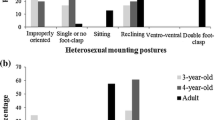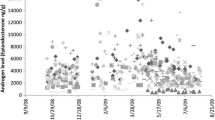Abstract
The sexual competence of males reared only with other males (isosexually reared) was compared to the sexual competence of males reared in mixedsex peer groups (heterosexually reared). All subjects were pair-tested with the same 11 females. Isosexually reared males tended to be less sexually active than heterosexually reared males, but the differences were not pronounced. Heterosexually reared males took less time to ejaculate than isosexually reared males, but their ejaculatory frequencies were comparable. Among one peer group of isosexually reared males, their level of sexual competence conformed with their dominance ranks when immature. These results suggest that growing up with female peers is not a prerequisite for the expression of adult sexual behavior among male rhesus macaques and that adult male sexual behavior may be influenced by relative dominance status when immature.
Similar content being viewed by others
References
Bercovitch, F. B., Goy, R. W., Scheffler, G., Wittwer, D. J., and Hempel, M. (1987). A benign method for maintaining ovulatory estrogen levels in cycling rhesus macaques.Am. J. Primatol. 13: 67–72.
Bercovitch, F. B., Sladky, K. K., Roy, M. M., and Goy, R. W. (1987). Intersexual aggression and male sexual activity in captive rhesus macaques.Agg. Behav. 13: 347–358.
Bielert, C., and Goy, R. W. (1973). Sexual behavior of male rhesus: effects of repeated ejaculation and partner's cycle stage.Horm. Behav. 4: 109–122.
Carpenter, C. R. (1942). Sexual behavior of free ranging rhesus monkeys (Macaca mulatta). I. and II.J. Comp. Psychol. 33: 113–162.
Chance, M. R. A (1956). Social structure of a colony ofMacaca mulatta.Br. J. Anim. Behav. 4: 1–13.
Chapais, B. (1983). Reproductive activity in relation to male dominance and the likelihood of ovulation in rhesus monkeys.Behav. Ecol. Sociobiol. 12: 215–228.
Colvin, J. (1986). Proximate causes of male emigration at puberty in rhesus monkeys. In Rawlins, R. G., and Kessler, M. J. (eds.),The Cayo Santiago Macaques SUNY Press, Albany, NY, pp. 131–157.
Conaway, C. H., and Koford, C. B. (1964). Estrous cycles and mating behavior in a free-ranging band of rhesus monkeys.J. Mammol. 45: 557–588.
Eaton, G. G., Johnson, D. F., Glick, B. B., and Worlein, J. M. (1985). Development in Japanese macaques (Macaca fuscata). Sexually dimorphic behavior during the first year of life.Primates 26: 238–248.
Goldfoot, D. A., and Wallen, K. (1979). Development of gender role behaviors in heterosexual and isosexual groups of infant rhesus monkeys. In Chivers, D. J., and Herbert, J. (eds.),Recent Advances in Primatology, Vol. 1, Academic Press, New York, pp. 155–159.
Goldfoot, D. A., Wallen, K., Neff, D. A., McBrair, M. C., and Goy, R. W., (1984). Social influences on the display of sexually dimorphic behavior in rhesus monkeys: isosexual rearing.Arch. Sex. Behav. 395–412.
Goy, R. W., and Wallen, K. (1979). Experiential variables influencing play, foot-clasp mounting, and adult sexual competence in male rhesus monkeys.Psychoneuroendocrinology 4: 1–12.
Goy, R. W., Wallen, K., and Goldfoot, D. A. (1974). Social factors influencing development of mounting behavior in male rhesus monkeys. In Montagna, W., and Sadler, W. A. (eds.),Reproductive Behavior Plenum Press, New York, pp. 223–247.
Kaufmann, J. H. (1965). A three-year study of mating behavior in a free-ranging band of rhesus monkeys.Ecology 46: 500–512.
Lindburg, D. G. (1971). The rhesus monkey in North India: an ecological and behavioral study. In Rosenblum, L. A. (ed.),Primate Behavior Academic Press, New York, pp. 1–106.
Loy, J., Loy, K., Keifer, G., and Conaway, C. (1984). The Behavior of Gonadectomized Rhesus Monkeys.Contrib. Primatol. 20: 1–144.
Michael, R. P., and Saayman, G. S. (1967). Individual differences in the sexual behavior of male rhesus monkeys (Macaca mulatta) under laboratory conditions.Anim. Behav. 15: 460–466.
Owens, N. W. (1975). Social play behavior in free-living baboons,Papio anubis.Anim. Behav. 23: 387–408.
Raleigh, M. J., Flannery, J. W., and Ervin, F. R. (1979). Sex differences in behavior among juvenile vervet monkeys (Cercopithecus aethiops sabaeus).Behav. Neurol. Biol. 455–465.
Reinhardt, V., Reinhardt, A., Bercovitch, F. B., and Goy, R. W. (1986). Does intermale mounting function as a dominance demonstration in rhesus monkeys?Folia Primatol 42: 55–60.
Rowell, T. E., and Chism, J. (1986). The ontogeny of sex differences in the behavior of patas monkeys.Int. J. Primatol. 7: 83–107.
Siegel, S. (1956).Non-Parametric Statistics McGraw-Hill, New York.
Slob, A. K., and Schenk, P. E. (1986). Heterosexual experience and isosexual behavior in laboratory-housed malw stump-tailed macaques (M. arctoides).Arch. Sex. Behav. 15: 261–268.
Sokal, R. R., and Rohlf, F. J. (1981).Biometry 2nd ed., Freeman, San Francisco.
Wallen, K., Bielert, C., and Slimp, J. (1977). Foot clasp mounting in the prebubertal rhesus monkey: social and hormonal influences. In Chevalier-Skolnikoff, S., and Poirier, F. E. (eds.),Primate Bio-Social Development, Garland, New York, pp. 439–461.
Wallen, K., and Goy, R. W. (1977). Effects of estradiol benzoate, estrone, and propionates of testosterone or dihydrotestosterone on sexual and related behaviors of ovariectomized rhesus monkeys.Horm. Behav. 9: 228–248.
Author information
Authors and Affiliations
Additional information
Funds were provided to the senior author through NIH Grant 5T32HD07118 and to the Wisconsin Regional Primate Research Center through NIH Grant RR00167.
Rights and permissions
About this article
Cite this article
Bercovitch, F.B., Roy, M.M., Sladky, K.K. et al. The effects of isosexual rearing on adult sexual behavior in captive male rhesus macaques. Arch Sex Behav 17, 381–388 (1988). https://doi.org/10.1007/BF01542479
Issue Date:
DOI: https://doi.org/10.1007/BF01542479




